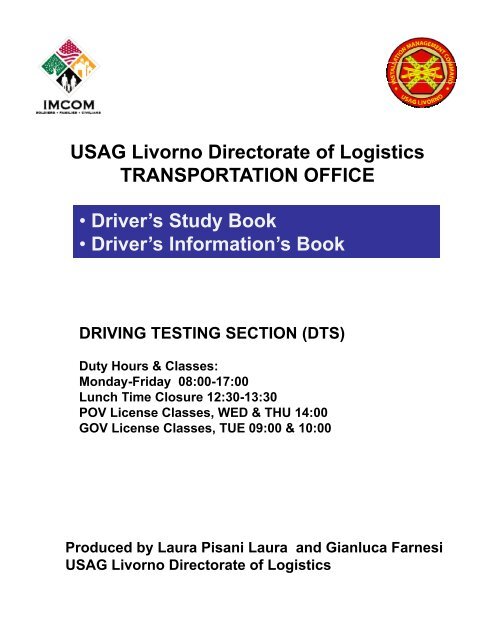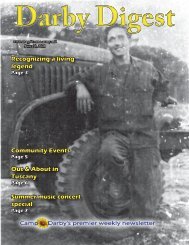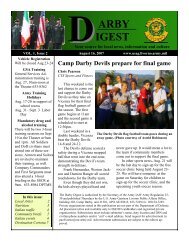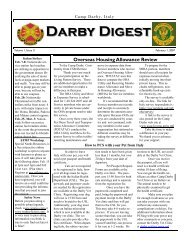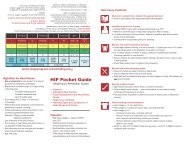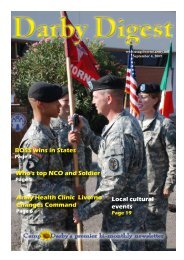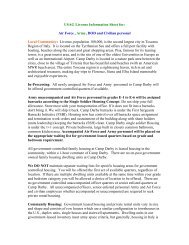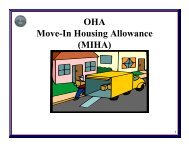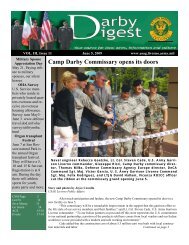Driver's Book - Darby Military Community - U.S. Army
Driver's Book - Darby Military Community - U.S. Army
Driver's Book - Darby Military Community - U.S. Army
- No tags were found...
You also want an ePaper? Increase the reach of your titles
YUMPU automatically turns print PDFs into web optimized ePapers that Google loves.
USAG Livorno Directorate of LogisticsTRANSPORTATION OFFICE• Driver’s Study <strong>Book</strong>• Driver’s Information’s <strong>Book</strong>DRIVING TESTING SECTION (DTS)Duty Hours & Classes:Monday-Friday 08:00-17:00Lunch Time Closure 12:30-13:3013 POV License Classes, WED & THU 14:00GOV License Classes, TUE 09:00 & 10:00Produced by Laura Pisani Laura and Gianluca FarnesiUSAG Livorno Directorate of Logistics
INTRODUCTION‣ POV & GOV license, Application Form AESE 190-2A‣ POV Driver’s Study Guide‣ Italians a an European signss‣ Test practice exercise‣ PMCS check list, Non-Tactical Vehicles (filling sample)‣ DA Form 2404, Equipment Inspection and Maintenance Worksheet (fillingsample)‣ Motor Equipment Utilization Record, (filling instruction)‣ Request for Mission Dispatch‣ Request for Mission Dispatch (filling sample)‣ Instruction to be followed in case of Accident‣ Motor Vehicle Accident Report, Standard Form 91‣ Standard Form 91 (filling sample)‣ Drivers Responsibilities driving GSA vehicles‣ Border Cross Authorization crossing Italian Border‣ IDP (International Driver Permit)‣ How to obtain an A.F.I. Motorcycle Endorsement‣ Temporary authorization to drive‣ Motorcycle PPE‣ Important Telephone Numbers‣ Tuscany, Map
SETAF POV AND GOVERNMENTDRIVER’S LICENSE1. AESE FORM 190-2a Signed by Unit Commander.(GS-07/E-7 and above can sign for themselves)2. COPY OF STATESIDE LICENSE3. COPY OF ORDERS FOR MILITARY AND CIVILIANS.LETTER OF EMPLOYMENT FOR LOCAL HIRECIVILIANSAll candidates need to sign in and pick up forms at TMP-1 prior tothe day of Driver’s Orientation Class & TestClasses are held at TMP-1 every Wednesday and Thursday at14:00Driving Testing Section is located at TMP-1, Bldg 703.POC: Mr.Gianluca Farnesi DSN 633-8161E-mail Gianluca.Farnesi@eur.army.mil
POV DRIVER’S STUDY GUIDELocated on the web at the following link:http://www.usag.livorno.army.milSelect Newcomers from the top-menuSelect: Driving in Italy
WARNING/DANGER SIGNSDanger. Posted before dangerous areas (forexample, construction sites).Bicycle Crossing. Indicates that cyclists maybe crossing the road.Double Curve. Indicates a double curve andits directions.Dangerous Downgrade. Posted before steepdowngrades; indicates degree of downgrade.Single Curve. Indicates a single curve and itsdirection.Men at work Indicates men at work aheadFalling Rocks. Indicates stretches t of roadwhere there is danger of falling rocksRough Road. Indicates uneven stretches t ofroad.Slippery Road. Indicates stretches of roadthat may be slippery when wet or dirty.Signal Lights. Indicates traffic light ahead.Loose Gravel. Indicates a stretch of road thathas loose surface material. Reduce speedand increase distance from the vehicle infront.Children. Posted where children may cross thestreet, particularly near schools or playgroundsQuay or River Bank. Posted near areaswhere there is danger of vehicles leaving theroad and entering a body of water.Drawbridge. Indicates a drawbridge ahead.Pedestrian Crosswalk. Indicates anupcoming pedestrian crosswalk.Unguarded Railroad Crossing. Posted 240meters before an unguarded railroadWild Animal Crossing. Indicates wildanimals may cross the road.Guarded Railroad Crossing. Posted 240meters before a guarded railroad crossing
PROHIBITED SIGNSEntry Prohibited. Prohibits entry for all typesof vehicles. Posted at the end of one-waystreets to prevent entry of vehicles from thewrong direction.Motor Vehicles Prohibition. Prohibits entry forall motor vehicles other than motorcyclesRoad Closed/Entry Prohibited. Prohibitsentry for all types of vehicles. A sign readingRESIDENTI posted underneath the diskmeans that t entry is permitted only to peoplewho reside or have business on the street.Maximum Weight Allowed. Indicates themaximum gross vehicle weight, in tons,permitted to proceed beyond this sign.No Passing. Prohibits passing motor vehiclesother than two-wheeled vehicles (bicycles andmotorcycles).Maximum Width Allowed. Posted beforenarrow places in the road (for example, bridges,tunnels); indicates the maximum vehicle width,in meters, of vehicles that may pass through theareaNo Passing. Prohibits trucks with a grossweight of over 3.5 tons and trucks or tractorspulling trailers to pass vehicles, except for twowheeledvehicles.End of No-Passing Zone. Indicates the end ofa no-passing zone for motor vehiclesMaximum Height Allowed. Posted before lowclearancestructures (for example, bridges,overpasses); indicates the vehicle maximumheight, in meters, of vehicles that may passunder the structure.Maximum Length Allowed. Prohibits trucksthat exceed the maximum length allowanceindicated on the signEnd of No-Passing Zone. Indicates the end ofa no-passing zone for trucksMotorcycles Prohibited. Prohibits entry formotorcycles with or without sidecar, mopeds, ormotor-assisted cycles.Speed Limit. Indicates the maximum speedallowed.No Stopping. Indicates drivers may not stopEnd of Speed Limit. Indicates the end of aspeed-limit zoneRestricted No Stopping. Indicates drivers maynot stop or park for longer than 3 minutes.
MANDATORY SIGNSMandatory Direction of Travel. Indicatesthat traffic must proceed straight ahead. Noturns are permittedRIGHT OF WAY SIGNSYield Right-of-Way. Indicates driver must yield totraffic on the upcoming priority road. If necessaryMandatory Direction of Travel. Indicatesthat traffic may proceed straight ahead orturn right, but may not turn leftStop. Indicates driver must come to a completestop before proceeding.Crossroads. Indicates an intersection or junction.Yield to traffic approaching from the right.Traffic Circle. Indicates entrance to a trafficcircle. Traffic in the circle has the right-ofway.Directional signals are not requiredwhen entering, but must be used whenexiting the circle.Mandatory Direction of Travel. Indicatesthat traffic must turn rightPriority Road. Indicates that traffic on this roadhas the right-of-way only at the next intersection.Signs are placed immediately before intersectionsin city limits and approximately 150 to 250 metersbefore intersections outside city limits.Oncoming Traffic. Posted where oncomingtraffic normally is not expected (for example,autobahns, and construction sites).Bicycles Only. Indicates paths restricted toand mandatory for bicyclesPedestrians Only. Indicates areas restrictedto and mandatory for pedestriansPriority Road. Indicates that traffic on this roadhas the right-of-way over traffic entering this roadat unmarked intersections. Outside of cities andcommunities, parking on a priority road isprohibited.End of Priority Road. Indicates the end of thepriority road and the end of right-of-wayBus Lane. Indicates a road restricted tobusesOncoming Traffic Must Wait. Indicates thatoncoming traffic (red arrow) must yield to traffictraveling in the opposite direction (white arrow).Snow Chains Mandatory. Posted wheresnow chains are required. The speed limit onroads marked by this sign is 50 kilometersper hour (kph) (31 miles per hour (mphYield to Oncoming Traffic. Indicates thatoncoming traffic (black arrow) has the right-ofway.Traffic traveling in the direction of the redarrow must yield to oncoming traffic.
PAVEMENTS MARKSPedestrian Crosswalk. Painted overa crosswalk. If a traffic island is in themiddle of the crosswalk, the stripes oneither side of the island are separatecrosswalks. Stopping or parking on orwithin 5 meters of a pedestriancrosswalk is prohibitedNo Parking. Painted on the road in azig-zag pattern to indicate areaswhere parking or stopping isprohibitedSolid White Line. Prohibits traffic frompassing on either side of the solid whiteline. Vehicles must not cross the solidwhite line, nor is it authorized formotorcyclists to lean over the line.Where a solid white line is used to markthe edge of the road, it is prohibited tostop or park on the left side of the line.Broken White Line. Used to marktraffic lanes or the center of the road.The broken line may be crossed onlyif passing can be done safely.Solid and Broken White Line.Indicates that passing is allowed fordrivers on the side of the broken lineand prohibited for drivers on the side ofthe solid lineBroken White Line. Used to marktraffic lanes or the center of the road.The broken line may be crossed only ifpassing can be done safely.Directional Arrows. Painted on theroad in front of an intersection towarn drivers to position their vehiclesin the correct lane. If the arrows arebetween solid white lines (markedtraffic lanes), the direction indicatedmust be followed once in the lane.Stopping or parking in a lane markedwith arrows between solid white linesis prohibited.
AutobahnAutobahn endsMotor vehiclesonlyEnd of motorvehicles onlyAutobahn exitDirection toautobahnDistance tonext change oftrafficAuto repairsGas station alsowith lead freefuelAutobahnsnackmachinesAutobahnrestaurantAutobahn hotelDanger Crossroads OncomingtrafficFallingstonesDangerstreetcarTents andtrailerscamping areaRadio station trafficinformationnumberFirst aid station Telephone Police Recommended Parking on Parking areaParking discPark and rideAutobahn Detour routespeedcurb permitted clockareadetour sign24 hour serviceoff of theautobahnFOR SAFETYYou must KNOWGerman traffic signsUSAREUR POSTER 190-34-12, Jan, 2001 (supersedes USAREUR Poster190-34, Nov95)http://rmv.hqusareur.army.milAutobahndirection signDirection toautobahnChange oftraffic lanesDirection signBypass routingDetourDirection of travelDirectional signEuropeanhighwayFederalhighwaynumberBuilt-up area(front)Built-up area(reverse)revisionSingle curve Double curve Road narrows RoadnarrowsNomotorcyclesSupplementalsignEnd of citylimitsDirection oftravel forbicyclesPoint ofinterestName placeStreetcar/busstopOccasionally usedwith supplementalsignsDanger ofunexpected iceOrange traffic arrowRecommendeddirection of travel instauSoft shoulderSecondary Rightofway GravelRoad damageroutechangedQuay or riverbankLow flyingaircraftPedestriancrosswalkaheadPedestriancrosswalkNo vehiclescarryingdangerous goodsResidents onlySpeed anddistance signSolid white lineBroken white linePassing onlyfrom brokenline sideOff limitsmarkingsArrow onpavementDirectionalarrowsPedestriancrosswalkNo parkingTraffic jamaheadTraffic jam areaaheadBicycle crossingDangerousdowngradeDangerousupgradeRough roadNo bicyclesSlippery roadLoose gravel Children ConstructionsiteDrawbridgeaheadWild animalcrossingDomesticanimalcrossingSide windSmogMotor vehicletraffic prohibitedSignal lightsaheadStopYield right ofwayMandatorydirection oftravelMandatorydirection oftravelMandatorydirection oftravelMandatorydirection oftravelTourist officeorinformationMaximumheight allowedMaximumwidth allowedMaximumweight allowedNo vehicles Vehicles above acarrying more specific axlethan 3000 liters of weight prohibitedpollutantsMotor vehiclesprohibitedTractors and truckswith an authorizedloaded weight ofmore than 3.5 tonsprohibitedMinimumdistancebetween vehiclesof 3.5tMaximumlength allowedNo U turnsProhibited forall vehiclesEntryprohibitedMandatorydirection oftravelMandatorydirection oftravelBeginning of apedestrianpriority areaEnd ofpedestrianpriority areaTraffic circleDistance toguarded railroadcrossingDistance tounguardedrailroadcrossingRailroadcrossingRailroadcrossingGuardedrailroadcrossingUnguardedrailroadcrossingSpeed zoneEnd of speedlimit restrictedareaSpeed limitEnd of speedlimitOnly when wetRight on redgreen arrowsignPedestrianzoneEnd ofpedestrianzoneChildrenplayingTrafficdirected byschool guardBus laneRestricted nostoppingNo stopping No passing End of nopassing zoneNo passing fortrucks in excessof 3.5 tonsauthorized weightEnd of nopassing zoneLimited parkingplace clock card inwindshieldEnd of limitedparking zoneEnd ofrestrictionMarks streetlightstli that are notlighted parklightsmust be left on atnightCustomscontrolOncomingtraffic has rightof waySnow chainsmandatoryHorse ridersonlyPedestriansonlyBicycles onlyInformation paneat frontiercrossingsPriority roadPriority roadEnd of PriorityroadRight of wayPriority roadaheadBridge carryingcapacity for NATOvehiclesOne way streetin direction ofarrow Dead end One-way traffic Oncomingtraffic mustwaitCompulsoryminimumspeed limitEnd ofcompulsoryminimum zoneSeparated bicycleand pedestrianpavementsrestricted speedareaJointly usedpavements forpedestrians andbicyclesTaxi parkingonlyWaterprotectionareaExit number
EXERCISES FOR PREPARATION OF TESTROAD SIGNS1 8 15 222 9 16 233 10 17 244 11 18 255 12 19 266 13 20 277 14 21 28
EXERCISES FOR PREPARATION OF TEST29 36 43 5030 37 44 5131 38 45 5232 39 46 5333 40 47 5434 41 48 5535 42 49 56
TEST EXERCISEEXERCISES FOR PREPARATION OF TESTSTOPDISTANCE TO GUARDED RAILROAD CROSSYELD RIGHT OF WAYONE WAY STREETQUEUE (TRAFFIC JAM)PROHIBITED FOR ALL VEHICLESDANGERUNGUARDED RAILROAD CROSSINGROAD NARROWMAXIMUM WEIGHT ALLOWEDDANGEROUS DOWNGRADEPEDESTRIAN CROSSWALKEND OF PRIORITY ROADNO STOPPINGNO PASSINGCHILDRENTRAFFIC ACCIDENT AHEADTRAFFIC CIRCLE AHEADABSOLUTE PRIORITY ROADCUSTOMS CONTROLCONSTRUCTION SITESINGLE CURVEROUGH ROADEND OF NO PASSING ZONESLIPPERY ROADSIGNAL LIGHT AHEADWILD ANIMAL CROSSINGONE WAY STREET IN DIRECTION OF ARROWMAXIMUM WIDTH ALLOWEDNO PASSING FOR TRUCKSMINIMUN SPEED LIMITMAXIMUM HEIGHT ALLOWEDENTRY PROHIBITEDPARKING AREAONCOMING TRAFFIC MUST WAITMAXIMUM SPEED LIMITCROSSROADSEND OF SPEED LIMITPEDESTRIAN CROSSWALK AHEADONCOMING TRAFFIC ( 2 WAY STREET)RIGHT OF WAY AHEADGUARDED RAILROAD CROSSINGMANDATORY DIRECTION OF TRAVELRESTRICTED NO STOPPINGDOUBLE CURVEONCOMING TRAFFIC HAS RIGHT OF WAYBICYCLE ONLYEND OF NO PASSING ZONE FOR TRUCKSNO PARKINGDRAWERIDGE AHEADFIRST AID STATIONTRUCKS AND TRACTORS PROHIBITEDPRIORITY ROAD WHEN ENTERING FROM RIGHTLOW FLY AIRCRAFTSIDE WINDFIRE HIGH RISK AREA
TEST CORRECTIONEXERCISES FOR PREPARATION OF TEST2631STOPMAXIMUM WIDTH ALLOWED2127DISTANCE TO GUARDED RAILROAD CROSS NO PASSING FOR TRUCKS3014YELD RIGHT OF WAYMINIMUN SPEED LIMIT5254ONE WAY STREETMAXIMUM HEIGHT ALLOWED1115QUEUE (TRAFFIC JAM)ENTRY PROHIBITED424PROHIBITED FOR ALL VEHICLESPARKING AREA3740DANGERONCOMING TRAFFIC MUST WAIT838UNGUARDED RAILROAD CROSSINGMAXIMUM SPEED LIMIT1748ROAD NARROWCROSSROADS4255MAXIMUM WEIGHT ALLOWEDEND OF SPEED LIMIT5623DANGEROUS DOWNGRADEPEDESTRIAN CROSSWALK AHEAD2241PEDESTRIAN CROSSWALKONCOMING TRAFFIC ( 2 WAY STREET)4445END OF PRIORITY ROADRIGHT OF WAY AHEAD293NO STOPPINGGUARDED RAILROAD CROSSING65NO PASSINGMANDATORY DIRECTION OF TRAVEL1618CHILDRENRESTRICTED NO STOPPING3632TRAFFIC ACCIDENT AHEADDOUBLE CURVE5125TRAFFIC CIRCLE AHEADONCOMING TRAFFIC HAS RIGHT OF WAY3547ABSOLUTE PRIORITY ROADBICYCLE ONLY1320CUSTOMS CONTROLEND OF NO PASSING ZONE FOR TRUCKS1250CONSTRUCTION SITENO PARKING739SINGLE CURVEDRAWERIDGE AHEAD199ROUGH ROADFIRST AID STATION2034END OF NO PASSING ZONETRUCKS AND TRACTORS PROHIBITED432SLIPPERY ROADPRIORITY ROAD WHEN ENTERING FROM RIGHT1033SIGNAL LIGHT AHEADLOW FLY AIRCRAFT128WILD ANIMAL CROSSINGSIDE WIND4649ONE WAY STREET IN DIRECTION OF ARROW FIRE HIGH RISK AREA
REQUEST FOR MISSION DISPATCH(For use of this form see USASETAF Suppl 1 to USAREUR Reg 58-1)TO:TMP1. SERVICE TO BE PERFORMEDSECTION I - REQUIREMENTFROM:DATE: [dd-MMM-yy]2. NUMBER OF PASSENGER 3. TYPE OF CARGO4. TYPE OF VEHICLE REQUIRED 5. DATE VEHICLEREQUIRED6. TIME VEHICLE REQUIRED:[hh:mm]7. PLACE TO REPORT 8. DESTINATION 9. MILEAGE ONE WAY10. DATE AND TIME OF11. OFFICIAL USER 12. POC – PHONE NUMBERRETURN13. NAME OF DRIVER*-14. ASSISTANT DRIVER REQUIRED PROVIDED BY15. ADDITIONAL REQUIREMENT16. REMARKSA. MONEY FOR AUTOSTRADA TOLL REQUIRED YES NOB. POL COUPONS REQUIRED YES NOC. CARABINIERI ESCORT REQUIRED** YES NO* When requesting nontactical vehicles, requesting unit may be required to provide the driver** Requestor must coordinate with PMO for Carabinieri escortREQUESTOR’S NAME, GRADE, TITLE AND PHONE NUMBER (Print /Type)SIGNATURESECTION II – ACTION BY APPROVING AUTHORITYTO: FROM: DATE:1. APPROVED GOVT TRANS COMMERCIAL POV OTHER2. DISAPPROVED (State Reason)NAME , GRADE, TITLE and TELEPHONE NUMBER (Print / Type)SIGNATURE
INSTRUCTIONS TO BE FOLLOWED IN CASE OF ACCIDENTRegulations prescribe that any accident or incident involving militaryvehicles must be reported to the nearest US <strong>Military</strong> Police Stationand/or the <strong>Military</strong> Police of the Headquarters to which the vehicle isassigned. All accidents/incidents, whether or not there is damage to themilitary vehicle, must be reported immediately. If circumstances do notallow it, the accident/incident will be reported within 24 hours. The TMPSupervisor/IFMS personnel are to be informed when this action hasbeen completedIn the event of an accident involving a TMP vehicle, no matter how minoror whether or not any damage has occurred, the following action must betaken by the driver/senior occupant of the vehicle:• Stop the vehicle.• Render assistance to injured or call for help as applicable.• Take precautions to prevent further accident or injuries by posting roadguides and warning triangles.• Report the accident to the nearest <strong>Military</strong> Police station by telephone.Ask local law enforcement for help if necessary. If this is not possibleand the accident is minor, report to the MP Desk Sergeant immediatelyupon return to the installation.• Obtain names and addresses of the persons involved with the accident.Make a sketch of the road where the accident occurred. A shortdescription of the road conditions will also be made before leaving thescene. (Use the SF 91, Operator’s Report of Motor Vehicle Accidentlocated in the log book)• Upon return to TMP, report the accident or incident id to TMP/IFMSpersonnel who will provide you with additional information.• Complete the Operator’s Report of Motor Vehicle Accident, SF 91, assoon as possible, leaving no blank spaces on the form by using N/A,None, or Unknown when necessary.• Damage, no matter how minor, must be reported to TMP no later than 24hours after the accident/incident. This must be accomplished by thedriver to whom the vehicle was dispatched or the individual whodiscovered the damage.
DRIVERS RESPONSABILITIESResponsibilities as an Operator of a GSA Fleet VehicleDo's and Don'tsThe operator of a GSA Fleet vehicle is responsible for its proper p use, maintenance, and protection.Abiding by the following Do's and Don'ts will help GSA keep costs down and provide the necessaryservices.DO DRIVE DEFENSIVELY AND SAFELY. The most important safety factor in an automobile is thedriver.Fasten Safety Belts. It's the law! Required by FMPR 101-39.300(c) and Executive Order 13043.Adjust head restraints so that the head is centered on the restraint.Use both the rearview and side-view mirrors and the turn signal before moving from one traffic laneto another.Use the emergency flasher lights when the vehicle becomes disabled or when stopping for anemergency on the side of the highway or any other public road.Obey all traffic laws. A traffic or parking violation is the personal responsibility of the operator.DO SAFEGUARD THE VEHICLE, CREDIT CARD(S), AND KEYS AGAINST DAMAGE, THEFT, ORMISUSE. Caution: the agency is financially responsible for losses due to vehicle theft, pilferage,vandalism, parking lot damages, and damages beyond normal wear and tear.Lock all doors and carry the keys and credit cards) when leaving the vehicle unattended.Turn in keys and a credit card when returning the vehicle to the FMC.Store the vehicle in a secure parking facility when possible.Report lost, damaged, d or stolen credit cards and/or license plates immediately to the FMC.Report the theft of the vehicle or its contents immediately to:- The local law enforcement agency- The FMC manager or the MCC technician- A supervisorSet the parking brake when leaving the vehicle.Carry a valid operator's permit for the type of vehicle operated, including a commercial driver'slicense for vehicles if required.DON'TS:DO NOT SMOKE. Smoking is prohibited in GSA Fleet vehicles.DO NOT Use the vehicle for private business, personal errands, or recreation. Avoid creating anyperception of misuse. Reported incidents of misuse often result in disciplinary actions.DO NOT Transport family members, personal friends, or non-Government employees in the vehiclewithout specific permission from the head of the agency or his or her designee.DO NOT Use the vehicle for transportation to or from work or park it at un-authorized residences'without valid written authorization, as required by FPMR 101.38-3.DO NOT Drive the vehicle without fastening the safety belt and ensuring all passengers havefastened theirs.DO NOT Use a cellular telephone when at a gas station. Cellular phone use at gas stations oranywhere fuel is stored is hazardous. The switches and high-powered batteries in the phone cangenerate sparks that can set-off explosions. In one incident, a driver suffered burns and the car wasseverely damaged when gasoline fumes ignited an explosion while talking on a mobile phone near agas pump. All electronic devices in gas stations are protected with explosive containment devices,while cell phones are not.
Carry a valid operator's permit for the type of vehicle operated, including a commercial driver'slicense for vehicles if required.DON'TS:DO NOT SMOKE. Smoking is prohibited in GSA Fleet vehicles.DO NOT Use the vehicle for private business, personal errands, or recreation. Avoid creating anyperception of misuse. Reported incidents of misuse often result in disciplinary actions.DO NOT Transport family members, personal friends, or non-Government employees in the vehiclewithout specific permission from the head of the agency or his or her designee.DO NOT Use the vehicle for transportation to or from work or park it at un-authorized residences'without valid written authorization, as required by FPMR 101.38-3.DO NOT Drive the vehicle without fastening the safety belt and ensuring all passengers havefastened theirs.DO NOT Use a cellular telephone when at a gas station. Cellular phone use at gas stations oranywhere fuel is stored is hazardous. The switches and high-powered batteries in the phone cangenerate sparks that can set-off explosions. In one incident, a driver suffered burns and the car wasseverely damaged when gasoline fumes ignited an explosion while talking on a mobile phone neara gas pump. All electronic devices in gas stations are protected with explosive containment devices,while cell phones are not.
BORDER CROSSINGPersonnel/Units wishing to use TMP/IFMS vehicles to traverse Austria andSwitzerland or any other Non NATO country, must first obtain Border Clearance(Authority to Transit) from the U.S Embassy for the country they are traversing.In addition to Border Clearance, Austria requires that the vehicle be covered byinsurance and the vehicle has a green EU insurance card in the vehicle. Inaddition, Austria requires the purchase of road sticker prior to the vehicle enteringthe country.To obtain Border Clearance, units must submit requests to the Dispatching OfficeThe following information must be providedMake and Model of vehicleCover Tag number and Admin NumberDate of departure and date of return.DestinationUnits/Sections requesting the use of TMP vehicles outside of Italy, must notify theDOL IFMS Fleet Manager a minimum of 5 working days prior to scheduleddeparture date in order to obtain border clearance and activation of Insurance.NOTE: Austria does not recognize a SETAF or OF 346 Drivers License. Austriaand Switzerland law requires a valid license issued by an EU country or a valid USdrivers license accompanied by an International Drivers License.
INTERNATIONAL DRIVER PERMITDoD employees assigned to Camp <strong>Darby</strong> and their dependents are eligible for a SETAF license which, inconjunction with your U.S. license, entitles you to drive in Italy. For information on getting a SETAFlicense, please contact the DOL Driver Testing office at DSN 633-8161. The SETAF license is validONLY in NATO countries (this does not include Switzerland or Austria). Also, the rules canvary based on official or unofficial travel and whether you are civilian or military. Althoughsome countries will accept your SETAF license or even a U.S. license, you are strongly encouraged toget an international driving permit (IDPs). IDPs are honored in more than 150 countries outside theU.S. For more information on applying for an international license, contact the DOL Driver Testingoffice at DSN 633-8161. Additional information can be found on the Travel State (US Department ofState) home page.
How to obtain an A.F.I Motorcycle Endorsement1. You must first be have a stateside or country motorcycle endorsement. You will need to presentyour endorsement. Learner’s permits are not authorized.2. You must be adhere to the following age requirements:Endorsement Category, Displacement, Age requirementA1 - Up to 50 cc 18 and olderA2 - Up to 250 cc 18 and olderA3 - 350 and above 21 and older3. You must register with IMCOM Europe.Click here: http://www.imcom-europe.army.mil/sites/management/so_atstp.asp4. For scheduled course dates and to start the registration process, click on “Click Here to Register”(red font).5. You will be redirected to https://airs.lmi.org/home.aspx6. Click on “View Available Courses” (blue font).7. Use the drop box features and enter the following information:a. Region: Europeb. Garrison: Livornoc. Courses: Motorcycle Basic Rider Course (for novice & re-entry riders) or MotorcycleExperienced Rider Course.8. A calendar will appear, click on the available training date and follow the on-screen instructions tocomplete the registration process.9. Once your registration is submitted and you have received a confirmation email, then you arelocked in the course.10. If you do not have a current A.F.I endorsement, then you must complete the following:a. Report to the Driver’s Testing Station 24 hours prior to the scheduled training date. Besure to have your stateside or country endorsement and the A.F.I Driver’s License readyfor inspection.b. You will receive a 48 hour temporary endorsement for the sole purpose of transportingyour motorcycle to the meeting area.11. If you do not have a motorcycle license plate, then you must complete the following:a. Have your motorcycle ready to pass the TCLOCS inspection (information on website).b. Have your motorcycle insurance documents ready for inspection.c. Ensure your motorcycle is registered.d. When you have your temporary endorsement, take your documents to the VehicleRegistration Office and you will then be issued a license plate.12. On the day of training, i we will all meet at the Driver’s Testing Station, ti Bldg #703.
DEPARTMENT OF THE ARMYU.S. ARMY GARRISON LIVORNOUNIT 31301CAMP DARBY, 56018 TIRRENIA (PISA)IMEU-LIV-LGTDATE:MEMORANDUM FOR ________Subject: Temporary Authorization to Ride Motorcycle1. This memorandum authorizes ______________________________________to operate his/her privately owned motorcycle between his/her place of residenceat ______________________________________________________________and the Camp <strong>Darby</strong> Motorcycle Safety Foundation training Course, bldg 702(Transportation Motor Pool)from_______________ to _____________ Operating a motorcycle to or from anyother location is not authorized and could result in revocation of SETAF driver licenseIAW revocation and suspension regulations and policies.2. This memorandum is only valid when the individual named above possesses avalid POV SETAF license (without motorcycle endorsement). The individual muststill meet all insurance and registration requirements for the motorcycle he/she willoperate.3. This memorandum only indicates that the individual has completed the writtenclassroom portion of the Motorcycle Safety Foundation (MSF) training and isauthorized to operate his/her motorcycle to/from and during the remaining portion ofthe MSF course for which he/she is currently enrolled. This temporary authorizationis IAW SETAF Regulation 190-2 dtd January 2007.4. If the above named individual is uncomfortable at anytime riding his/her POVmotorcycle he/she should find a legally licensed motorcycle rider to bring themotorcycle to the training course for him/her.5. Only valid when signed and stamped below by the USAG-Livorno TMP licensingofficer.USAG-Livorno Transportation Officer
Motorcycle,PPE PP
Transportation Motor Pool , Telephone NumbersTMP, Main Office 633‐8160TMP, Dispatcher Office 633‐8162Dii Driving Testing Section 633‐8161Fax 633‐8168Important Telephone NumbersEmergency 911MP DESK 050‐54 7575<strong>Darby</strong> Operator 050‐54 54 7111Vicenza Operator 0444‐71 113Aviano Operator 0434‐30 1110American Red Cross (Vicenza) 0444‐71 7089Emergency Numbers Livorno/Pisa AreaCarabinieri 112Fire 115Emergency 113Ambulance 118Hospital, Livorno 0586‐223111Hospital, Pisa 050‐92111
Marina Di PisaHotel ManziTMPTIRRENIAMain SquareTIRRENIASouthLivornoVia PratoLivornoViale ItaliaLIVORNO AREA
LIVORNO AREANODICAChurchMIGLIARINOChurchPISA TrainSTATIONTMP4LivornoVia PratoPISA AREA
TMPPontederaVia diCavaPonsaccoVia dellaConcaCENAIA/ PONSACCOAREA
Camp<strong>Darby</strong>


